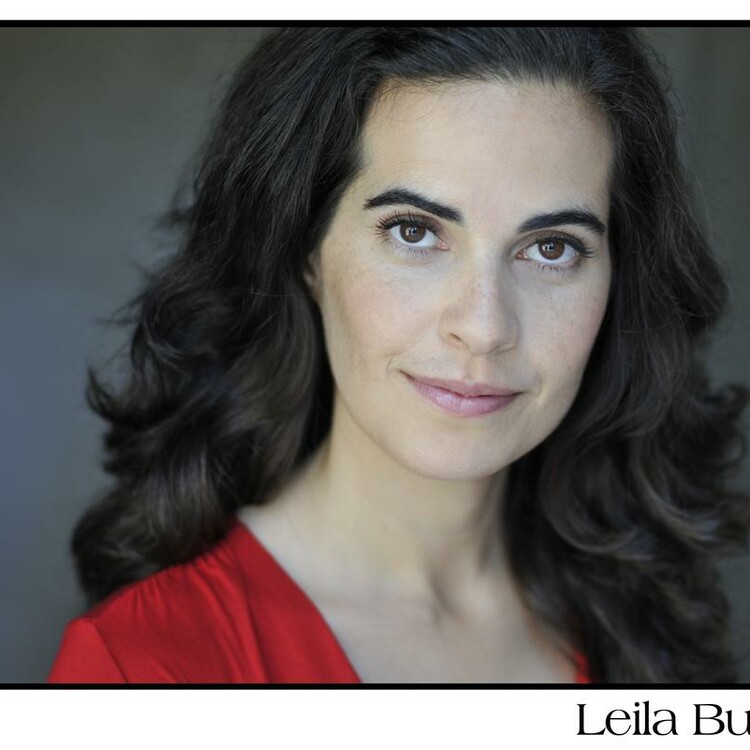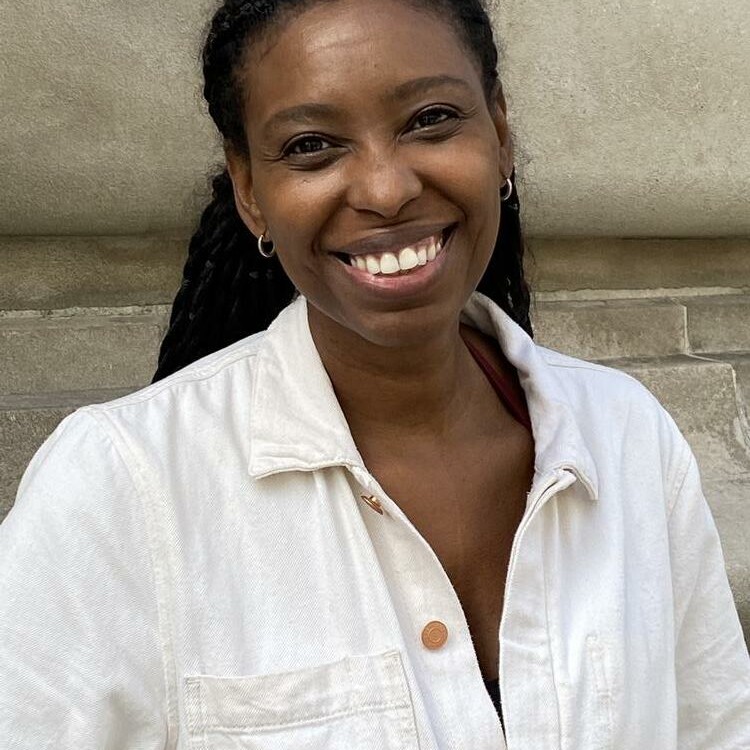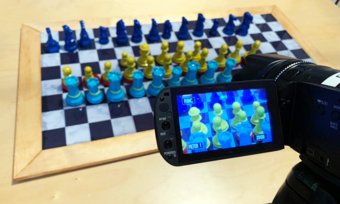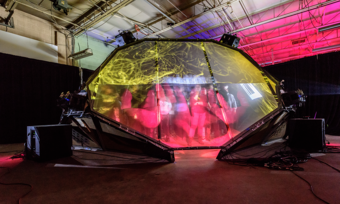Zeina Salame: I felt so moved by the way American Dreams models the radical potential of deploying strategic audience participation and engagement.
Leila Buck: Tamilla and I often use the word “interactive” more than “participatory.” “Participation” sometimes implies “you can come and participate in my thing that I have made” whereas “interaction” suggests more of an open engagement.
Zeina: It takes great trust to ask the audience to join you as collaborators. I’ve seen you take that leap across your body of work, Leila, and prominently in American Dreams.
Tamilla Woodard: It takes a particular kind of writer who trusts that the “liveness” of the event is in the people who have gathered.
Leila: Well I think it was you who said this first Tamilla: When asking for direct participation that affects the outcome of the piece, you don’t have your first full rehearsal until your first audience joins you. Because they are your final collaborators. And when they join, the goal is that their participation is not perfunctory. It isn’t just, “Participate, but only in this narrow way I have decided for you to fulfill the outcome I want.”
Zeina: Which I felt. I knew my input about the “contestants” was literally changing the game.
Leila: I’m so glad you felt that. The intention is to create a space in which audiences and creators don’t control and know everything that will happen. If you want total control, you aren’t actually inviting real engagement. And you’re not reflecting the messiness of any attempt at democracy. People often ask us, “What’s the American dream to you?” And to me, that’s it—to be able to gather together and impact one another and change ourselves and this place for the better in real and meaningful ways.
If you want total control, you aren’t actually inviting real engagement. And you’re not reflecting the messiness of any attempt at democracy.
Zeina: By giving up total control over what might happen in a given moment, by giving over as creators in that way, you gave us audience members power over the story that got told. And by giving us power, you created a space through which we were obligated to reflect on our own power.
Tamilla: Which was 100 percent the goal. The story is in the audience. We are just a demonstrator of the possibility of the drama, but the actual drama is happening inside each of the audience members.
Leila: Of course, the majority of the piece is scripted. But the idea is to create multiple invitations to different levels of engagement throughout, and trust in our collaborators and the structure we’ve created enough that we can handle whatever the spontaneous responses are within that structure.
Tamilla: We lay out a possible path so that we are moving as a unit together, but we also understand the power of gathering and the power of individual response. It’s like playwriting, directing, predictive analysis, and human psychology combined. We place breadcrumbs and maybe they follow them this way or that way. And it requires us to make an audience feel like it’s low stakes, that they can’t mess it up, to encourage the degree of participation necessary.
Leila: So if people want to just watch and vote anonymously on the questionnaires and polls, they can. If they want to be on screen and volunteer to answer trivia questions, or tell us about a dream they’ve had, they can. Or, in the “hot seat” section, they can offer any question, unscreened, to a contestant. Whatever they feel they need to know in order to decide whether this person should be their newest neighbor. Because like any dialogue, for it to be meaningful there has to be room for as much open-ended engagement as possible. The rule we always remind ourselves of as creators is: “Don’t ask questions you don’t want real answers to.” Particularly if we want to engage people who don’t all have the same opinion or beliefs about something divisive...
Zeina: Like how we define “democracy,” “freedom,” and “the American dream,” as this show invites people to reflect on.
Tamilla: Yes! We work hard against audiences entering the work thinking, I’m actually simply invisible. Audiences are not invisible. They are absolutely there. And by making the audience interaction physical—
Zeina: —like through all of the ways we actively used our bodies and voices in order to help move the story forward, filling and typing things out, waving, applauding, speaking… It broke through the “virtual” boundaries by putting the experience back in our bodies in a purposeful way.
Tamilla: Exactly. Audiences are in action the whole time in the way that actors are in action.
We work hard against audiences entering the work thinking, I’m actually simply invisible. Audiences are not invisible. They are absolutely there.
Zeina: I particularly felt that in the “hot seat” section, where the game show host characters asked scripted questions of the immigrant contestant characters and audience volunteers were invited to ask their own questions. The “temperature checks” throughout that section invited us as audience members to give a physical thumbs up/thumbs down/so-so gesture to express our responses to the contestants’ answers. And having to offer value judgements at all, much less through the use of only a thumbs up/down action, wasn’t easy! We struggled. We tried to negotiate it to be more fair and nuanced by putting tension into that gesture and expression on our faces when we wanted to problematize or critique the actual questions that were asked or avoid judging the contestants. We tried to show when we were in disagreement with each other’s responses or with the actual process of vetting these characters.
Leila: I love watching that happen and hearing people reflect on that experience. If an audience member sees ten people on the screen with different responses than theirs, do they begin to question or change their own response? What is the role of collective consciousness in this and every process of making decisions as a group?
Tamilla: And oh my gosh, we’ve had amazing protestors, amazing.
Leila: We’ve had people unmute themselves and protest the questions or the whole process of judgment/voting, and hold up signs—
Tamilla: People saying out loud during the voting, “You must resist! You must resist! We have to resist!”
Zeina: The piece intentionally juxtaposes its immersive inclusion of audience participants with dramatizations of alienation. Part of the drama comes in the way this piece shatters illusions of the “American dream” as perfectly equitable, calling it out as also biased and exclusionary.
Leila: Speaking of exclusionary: One big question that came up in this process was how—in a piece that deliberately immerses the audience from pre-show onwards in a government-run game show that would never acknowledge the existence of Native and Indigenous peoples—do we at the very least acknowledge the vital role of those communities in any dialogue about immigration and citizenship, and acknowledge the fact that they are far too often excluded from these conversations?
Tamilla and I did our best, in consultation with Dr. Bryan Brayboy and DeLanna Studi, to invite that recognition in a series of slides, which became a key part of the conclusion of the experience. We tried to emphasize this issue to the audience in a way that wasn’t just a footnote or afterthought and also worked artistically given the world we created, and to invite them to go beyond acknowledgment to engagement, highlighting specific organizations and calls to action. And it’s definitely not perfect—it’s something I continue to reflect on and learn from both for future productions of this piece, inshallah, and everything I create.
Zeina: Leila, you and I are both engaged in various artistic and scholarly projects around our identities as Arab Americans, and through which we confront our personal/political experiences of (mis/under)representation. It seems especially important for those of us telling immigrant-diaspora stories to meaningfully acknowledge Native and Indigenous communities because of our complicity in settler colonialism. So many of us only get to speak to the experience of being immigrants and the children of immigrants in the United States because of what was stolen from Native and Indigenous communities.
Leila: Exactly. That’s a big part of what we did our best to communicate in the show’s closing sequence.
Process makes its way into product one way or another. They’re not separate. And the audience can see and feel that.
Zeina: There’s a clear passion for social justice in American Dreams. Without giving too much away, the lightheartedness of the game show experience does take a turn later in the show. Offenses by the play’s fictionalized government game show and some of its characters demonstrate examples of xenophobia, racism, and bigotry, as well as some potential consequences of the abuse of power. I see social justice as not just a theme, but a necessary intervention in the field, a methodology, and an aesthetic. We are responsible for the reverberations of the images we make and the legacies of the stories we share. And even the most righteous of thematic values can be undermined by hypocrisies in our ways of working by ignoring systemic inequities within our field of theatremaking.
Tamilla: How you work is the work. Process makes its way into product one way or another. They’re not separate. And the audience can see and feel that. The same way one has to consider how content determines form. What’s the best means by which to disseminate this experience or share this story? And how we treat each other shows in the work we share.
Zeina: You’ve both mentioned to me that the show’s video designer, Kate Freer, reminded you this is a “site-specific piece” and the site is Zoom. I think there’s also another site: home. The actors performed the piece from their respective homes and presented it directly into ours—the place where we watch real-life game shows. All this supporting a narrative about seeking out America as home…
Tamilla: We are offering a kind of American dream to the “contestants,” which they can see inside the audience members’ houses, like, “This is what awaits you!”
Leila: One of the great gifts of this online version has been seeing inside people’s homes—kids and dogs and kitchens and family members… It feels like there’s more openness in people’s responses because they are in their homes, or in relatively private spaces, not in a theatre. That intimacy also has an impact on their responses and their votes.
Zeina: On the afternoon I attended American Dreams, one of the other audience members was eating spaghetti. When they finished, they switched from their home computer to their phone and went for a walk. The sky was bright blue, sun shining, fluffy white clouds in the sky, people strolling past… It certainly drew my eye and, yes, it could have been perceived as a mistake or “bad” audience behavior, but it also became this ultra-fitting backdrop for the show and a pastiche of images of neighborhood, community, and home.
Leila: Yes! I love that too, when that happens. Don’t invite the audience to have their cameras on if you aren’t prepared for them to be making dinner, or going for a walk, or whatever!
Tamilla: In the theatre, we have these rituals: come in, sit down, turn off your phone. Because essentially we don’t trust each other’s behavior and the performance is the most important thing. But I think with American Dreams, in our space the most important thing is the gathering.
Leila: Yes. And the journey the audience takes in that gathering. And how it reflects, and hopefully impacts, our beliefs and actions beyond it.













Comments
The article is just the start of the conversation—we want to know what you think about this subject, too! HowlRound is a space for knowledge-sharing, and we welcome spirited, thoughtful, and on-topic dialogue. Find our full comments policy here